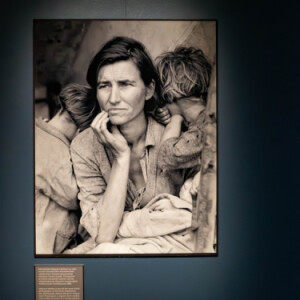The Great Depression
I had flexi leave today - my daily working hours are short because of partial disability pension, and that's why I often work excess hours and my working hours bank is almost full.
In the afternoon we drove to Tampere: I went to a photography exhibition opening to Werstas, meanwhile hubby and Peetu had a rainy walk.
The exhibition presents photos of Dorothea Lange. In the Werstas museum there is about 60 photographs from the collection of Library of Congress of the United States
Dorothea Lange (1895–1965) in an iconic figure in documentary photography. Her photography career blossomed during the 1930s when she joined the Farm Security Administration (FSA). The department was set up to combat American rural poverty and Lange’s work humanized the consequences of the Great Depression and influenced the development of documentary photography.
Dorothea Lange's compassionate and empathetic approach to her subjects set her apart, enabling her to reveal the raw emotions and struggles of Americans. Through her lens, she documented the human toll of economic hardship and social injustice. When setting up a shot, Lange often moved slowly, fiddling with her camera and the lighting until her subjects relaxed. This care and consideration led to thousands of images that felt honest and allowed viewers to connect to her images on a deeper level.
Pictures were interesting and impressive, and I learnt a lot of the Great Depression. For instance, I didn't know about the Dust Bowl!
Economic depression coupled with extended drought, unusually high temperatures, poor agricultural practices and the resulting wind erosion all contributed to making the Dust Bowl.
In the exhibition there was also the most iconic photograph of the Great Depression: Migrant Mother. (See the extra)
Lange encountered a mother and her children. “I saw and approached the hungry and desperate mother, as if drawn by a magnet,” she later recalled. “She said that they had been living on frozen vegetables from the surrounding field and birds that the children killed.” Lange took seven exposures of the woman, 32-year-old Florence Owens Thompson, with various combinations of her seven children. One of these exposures, with its tight focus on Thompson’s face, transformed her into a Madonna-like figure and became an icon of the Great Depression and one of the most famous photographs in history.
It was great exhibition, I'm happy that I went to see it! I met Nina there, classmate of my photography studies. It was lovely to see her and have a chat.
Later we picked up Emma from Hervanta and spent pizza Friday at home.
Have a great weekend!
+5,5 °C, cloudy and rainy


Comments
Sign in or get an account to comment.


